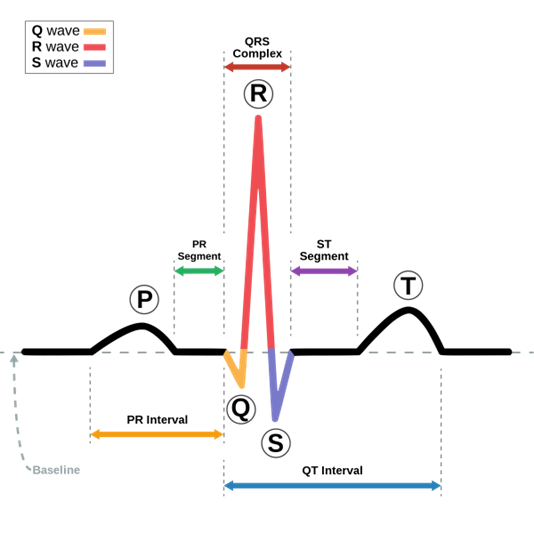In the normal electrocardiogram, the PR interval represents
Atrial depolarization
Ventricular depolarization
Atrial activation of the onset of ventricular activity
“electrical systole” of the ventricles
The Correct Answer is C
In the normal electrocardiogram, the PR interval represents

The PR interval represents the time from the onset of atrial activation to the onset of ventricular activity. During this time, the electrical impulse travels through the atria, the atrioventricular (AV) node, and the bundle of His before entering the ventricles and initiating ventricular depolarization. Option A is incorrect because the atrial depolarization is represented by the P wave. Option B is incorrect because the ventricular depolarization is represented by the QRS complex. Option D is incorrect because there is no such term as “electrical systole” of the ventricles in ECG interpretation.
Nursing Test Bank
Naxlex Comprehensive Predictor Exams
Related Questions
Correct Answer is A
Explanation
Coronary artery disease (CAD) is a condition where the arteries that supply blood to the heart become narrowed or blocked due to a buildup of plaque. Several risk factors contribute to the development of CAD, including diabetes mellitus, hypertension, obesity, high alcohol consumption, smoking, and a family history of CAD.
Research suggests that individuals with diabetes mellitus are two to four times more likely to develop CAD than those without diabetes. This is because diabetes can lead to damage to the blood vessels and nerves that control the heart, as well as increased inflammation and high levels of blood glucose that can contribute to the buildup of plaque in the arteries.
While hypertension, obesity, and high alcohol consumption are also known risk factors for CAD, they generally do not increase the risk to the same degree as diabetes. Nonetheless, these factors can contribute to the development and progression of CAD and should be addressed through lifestyle modifications and medical interventions.
Correct Answer is A
Explanation

Acute respiratory distress syndrome (ARDS) is the most likely diagnosis based on the patient's symptoms and test results. ARDS is a serious condition that can develop in response to a variety of lung injuries, including pneumonia, sepsis, and trauma. The hallmark of ARDS is diffuse alveolocapillary injury, which leads to decreased lung compliance, hypoxemia, and respiratory distress. The symptoms of ARDS typically develop rapidly and include dyspnea, rapid, shallow breathing, inspiratory crackles, and hypoxemia. Treatment for ARDS typically involves supportive care, including oxygen therapy, mechanical ventilation, and treatment of the underlying cause of the lung injury.
Whether you are a student looking to ace your exams or a practicing nurse seeking to enhance your expertise , our nursing education contents will empower you with the confidence and competence to make a difference in the lives of patients and become a respected leader in the healthcare field.
Visit Naxlex, invest in your future and unlock endless possibilities with our unparalleled nursing education contents today
Report Wrong Answer on the Current Question
Do you disagree with the answer? If yes, what is your expected answer? Explain.
Kindly be descriptive with the issue you are facing.
